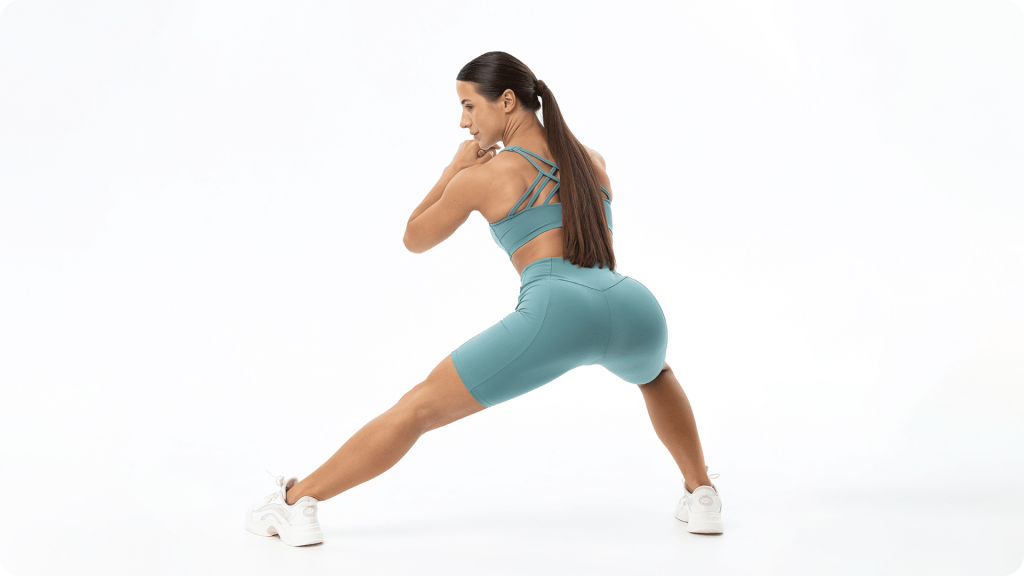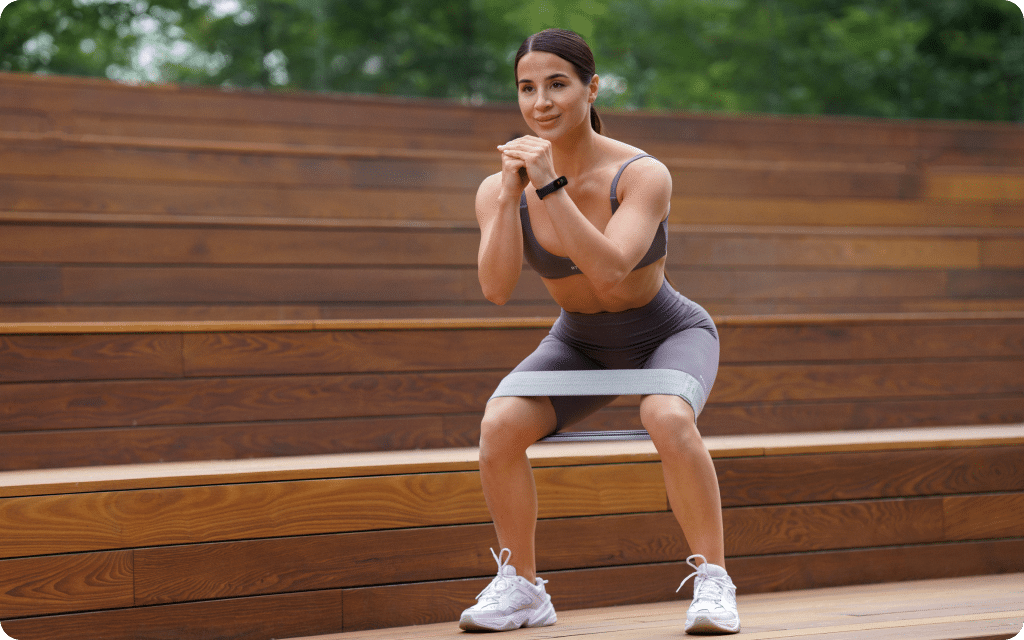The gluteal muscles are notoriously difficult to grow, but strong, well-developed glutes play a key role in posture, mobility, and athletic performance (1). Building them often requires focused effort and strategic workouts.
Weight training is a common approach, known for its ability to sculpt and strengthen. But where does Pilates fit into the picture? Can these controlled, low-impact movements create results comparable to weights?
Let’s find out how Pilates stacks up when it comes to glute development.
Can Pilates Build Glutes?
Pilates can strengthen and tone the glutes, making them firmer and more functional (2). For those who are looking for aesthetic gains or significant size increases, it works best as part of a broader fitness plan that includes heavy resistance training.
How Muscles Grow (Hypertrophy)
Before we get into Pilates, it’s vital to understand muscular hypertrophy. This refers to the growth in muscle size that is caused by repeated stress or resistance (3). To achieve hypertrophy, two key elements are essential: progressive overload and sufficient intensity (4).
Progressive overload involves gradually increasing the demand placed on a muscle (e.g. by adding weight or resistance over time). Without it, muscles plateau and stop growing. Intensity is about how much stress the muscle is placed under during exercise (5).
BetterMe: Health Coaching app helps you achieve your body goals with ease and efficiency by helping to choose proper meal plans and effective workouts. Start using our app and you will see good results in a short time.
Pilates and Glutes Activation
Pilates incorporates bodyweight movements, emphasizing slow, controlled motion and alignment. Many Pilates exercises, such as bridges, side-lying leg lifts, and clamshells, target the gluteal muscles. The primary glutes include:
- Gluteus Maximus: The largest glute muscle responsible for extending the hip (6).
- Gluteus Medius: Important for stabilizing the pelvis (7).
- Gluteus Minimus: Supports hip rotation and stability (8).
Pilates is excellent for activating these muscles. It encourages smaller, stabilizing muscles to join in, and its controlled nature ensures that you’re firing the right areas (e.g. strengthening the gluteus medius to avoid relying too heavily on the quads).
However, Pilates exercises often use body weight or resistance bands, which makes the intensity relatively low. This is great for building muscular endurance and improving muscle control, but it may not be enough for significant hypertrophy.
What Research Says
Studies have shown that Pilates can improve core and lower-body strength (9). For example, research on mat-based Pilates has indicated improvements in glute strength and tone (2). However, the intensity of Pilates typically falls into the low to moderate range. This means while it’s great for toning and activating the glutes, it doesn’t usually create the conditions necessary for hypertrophy.
Why? Because hypertrophy relies on lifting heavier loads or pushing the muscles to higher levels of fatigue, which Pilates doesn’t consistently provide.
Pilates for Glute Building: Strengths
- Improved Muscle Activation
Pilates emphasizes engaging muscles intentionally. This improves the ability of the glutes to fire properly during daily activities or other workouts. - Enhanced Core-Glute Connection
Pilates focuses on working the posterior chain (the muscles along the back of your body, including the glutes and spine). This synergy helps build a stronger, more functional lower body. - Versatility
Exercises such as side-lying clamshells or bridges are excellent ways to isolate and wake up the glutes, which are often neglected in traditional strength routines. - Low Impact
It’s gentle on the joints while still providing a burn. This is excellent for beginners or those who are recovering from injury.
Pilates Limitations for Glute Growth
- Lack of Progressive Overload
Performing bodyweight bridges or leg lifts won’t significantly stimulate muscle growth after a certain point. Muscles adapt quickly, and without heavier resistance, hypertrophy stalls. - Low Intensity
The glutes are large, powerful muscles. They typically require substantial loads or resistance to grow significantly. - Not Focused Solely on Hypertrophy
Pilates is a full-body system that develops flexibility, balance, and strength. However, it’s not designed with maximal muscle growth in mind.
Building Better Glutes with Pilates and More
If your goal is bigger glutes, here’s what you can do:
- Combine Pilates with Strength Training
Use Pilates to improve muscle activation and mobility, and pair it with heavy lifts such as glute bridges, barbell squats, or Romanian deadlifts for hypertrophy. Pilates will prime your glutes to work better during heavier lifts. - Add Resistance to Pilates Exercises
Introduce resistance bands, ankle weights, or reformer machines for Pilates glute work to increase intensity. - Focus on Nutrition
Muscle growth requires protein-rich diets and sufficient calories. If you’re burning a lot of calories during Pilates, ensure you’re eating enough to support recovery (10). - Prioritize Recovery
Rest and proper sleep allow muscles to rebuild and grow stronger (11). - Train Consistently
Aim for 2-4 days of glute-focused resistance training, with Pilates serving as a complementary practice to refine muscle engagement.
Read more: Pilates Body Vs Gym Body: A Clear Comparison of Results and Approach
Do Glutes Grow with Weight or Reps?
Glutes need both weights and reps to grow. To grow a muscle, you need to create mechanical tension, muscle damage, and metabolic stress (4):
- Mechanical Tension
This happens when your muscles bear a heavy load. Think squats or deadlifts. The greater the tension, the stronger the growth stimulus. - Muscle Damage
Small tears in muscle fibers occur during hard workouts. These tears repair and grow larger over time. Achieving this requires either heavier weights or high-effort sets. - Metabolic Stress
The “burn” you feel during higher-rep sets comes from accumulating lactic acid. This stress signals your muscles to adapt.
These three factors work together to build muscle, but how you achieve them can vary based on how you train.
The Role of Weight (Intensity)
Training with heavier weights is critical for stimulating growth, particularly in larger muscles such as the glutes. Heavy loads create more mechanical tension. This leads to stronger signals for hypertrophy (5).
For effective glute growth with heavier weights:
- Keep your reps low to moderate (6-12 per set).
- Use compound exercises such as barbell squats, hip thrusts, and Bulgarian split squats. These movements hit all the fibers in the glutes (12).
Heavy lifting also recruits fast-twitch muscle fibers. These fibers are responsible for power and force. They also have the highest potential for growth (13).
The Role of Reps (Volume and Endurance)
High-rep, low-weight training focuses on volume and endurance (14). You’re creating more metabolic stress rather than tension. Exercises such as resistance band kickbacks or high-rep donkey kicks burn the glutes and enhance endurance but often fall short of causing significant hypertrophy.
That being said, higher reps can still play an important role:
- They improve muscular engagement and endurance, preparing muscles for heavier lifts.
- They target slow-twitch fibers, which contribute to muscle tone and definition (15).
Which Is Better for Glutes?
The truth is, you need both weight and reps for optimal results. Here’s how you can balance the two:
1. Prioritize Progressive Overload
This is the gradual increase of stress placed on your muscles (16). Whether you’re lifting heavier weights over time or increasing reps, progressive overload ensures the glutes stay challenged and continue to grow.
2. Mix Heavy Strength Days with Volume Days
- On certain days, focus on heavy compound lifts with low to moderate reps (e.g. squats for 6-8 reps). This builds strength and thickness.
- On other days, include higher-rep accessory work (e.g. lunges or cable kickbacks for 12-20 reps). These refine techniques and maximize endurance.
3. Don’t Neglect Recovery
Training too hard without recovery can stall growth. Allow at least 48 hours of rest between intense glute sessions. Sleep and nutrition also matter (17).
4. Focus on Form
Whether lifting heavy or working through high reps, muscle activation is key. Make sure you truly feel the glutes working. Otherwise, other muscles (such as the quads or hamstrings) may take over.
Is Pilates Better than the Gym for Glutes?
Pilates and gym workouts each bring unique advantages to the table. Your choice will depend on your goals and preferences.
- Pilates for Glutes
Pilates focuses on precision and control. It’s excellent for activating the glutes, improving stability, and building endurance. Exercises such as bridges, side-lying leg lifts, and clamshells are staples that target the glutes effectively.
With Pilates, you’ll develop a strong mind-muscle connection, which is essential for maximizing engagement during any workout (18). It also strengthens supporting muscles (such as the core), enhancing balance and reducing the risk of injuries (9). This makes it ideal for beginners and those who are seeking functional strength.
However, Pilates tends to lack progressive overload (gradually increasing resistance), which is crucial for significant muscle growth, or hypertrophy.
- Gym for Glutes
Gym workouts shine in their ability to create mechanical tension in muscles by using heavier weights and machines. Squats, deadlifts, and hip thrusts are unparalleled for building glute size and strength (12).
The gym allows you to progressively overload the glutes, challenging them in ways that bodyweight Pilates exercises cannot. It also caters to hypertrophy by recruiting fast-twitch fibers, which have the greatest growth potential.
That being said, gym routines can sometimes neglect proper engagement, leading to subpar results if other muscles compensate (e.g. quads or hamstrings). This is where Pilates-inspired activation techniques can come in handy. If you’re curious about the best exercises for hamstrings and glutes, check out our earlier article.
- The Verdict
Rather than choosing one over the other, consider combining Pilates with gym training. Use Pilates for glute activation, mobility, and endurance, and the gym for heavy lifting and hypertrophy.
Together, these methods create a comprehensive plan to sculpt glutes that are strong, functional, and aesthetically pleasing. Whether you’re looking to tone or grow, there’s a place for both in your routine.
Read more: Pilates for Legs: 12 Exercises to Add to Your Routine
What Type of Pilates Is Best for Glutes?
Reformer Pilates brings a game-changing element to glute training. The reformer machine uses springs to add resistance to exercises like footwork, leg presses, and hamstring curls. This added load allows for more mechanical tension, which is essential for hypertrophy (19).
Reformer Pilates also provides smoother motion and supports proper alignment, which enables you to target the glutes more effectively. If you’re looking to strengthen and shape your glutes while enjoying a higher-intensity workout, reformer glute exercises are a fantastic option.
Which Pilates Exercise Builds Glutes the Most?
Exercises that focus on activation, endurance, and balance tend to have a lot of potential.
The shoulder bridge stands out. Research measuring the electromyographic activity of the gluteus maximus has shown that the shoulder bridge produces higher activation compared to other Pilates movements. This makes it a solid choice for engaging and strengthening the glutes (20).
Other exercises such as pelvic elevation and bird dog also target the gluteus maximus but emphasize balance and control rather than maximal muscle recruitment.
It’s important to note that Pilates isn’t primarily designed for hypertrophy (muscle growth). Instead, it excels at improving glute activation, functional strength, and postural support.
For those who are aiming to build strong, well-rounded glutes, the Pilates glute exercises above can be a valuable addition to your routine.
However, for significant muscle growth, these exercises are best used in combination with traditional strength training methods such as squats or glute bridges with added resistance. This blended approach will ensure glutes that are strong, balanced, and functional.
Reasons why BetterMe is a safe bet: a wide range of calorie-blasting workouts, finger-licking recipes, 24/7 support, challenges that’ll keep you on your best game, and that just scratches the surface! Start using our app and watch the magic happen.
Shoulder Bridge (Mat-Based)
The shoulder bridge is renowned for its ability to achieve high glute activation while also engaging the hamstrings and core.
Steps:
- Lie on your back on a mat with your knees bent and your feet flat on the floor, hip-width apart. Place your arms by your sides with your palms facing down.
- Engage your core by pulling your belly button toward your spine. Squeeze your glutes tightly.
- Press through your heels to lift your hips off the mat, forming a straight line from your shoulders to your knees. Avoid overarching your lower back.
- Hold this position for a few seconds, focusing on squeezing your glutes at the top of the movement.
- Slowly lower your hips back down to the mat, one vertebra at a time, maintaining control.
- Repeat for 10-12 repetitions, ensuring consistent glute engagement throughout.
Pelvic Elevation (Performed on Mat or Reformer)
Pelvic elevation is an excellent exercise for targeting the glutes and promoting pelvic stability.
Steps (Mat Version):
- Lie on your back on a mat, with your legs bent and your feet resting flat on the ground. Ensure your feet are placed close to your glutes.
- Engage your core and glutes to lift your pelvis upward, creating a diagonal line from your shoulders to your knees.
- Hold the position briefly, tightening your glutes to avoid using your lower back.
- Slowly lower your pelvis back to the mat with control and repeat 10-12 times.
Steps (Reformer Version):
- Lie on your back on the reformer with your feet propped on the foot bar and your knees bent.
- Push through your heels to extend your hips upward while your shoulders remain grounded against the carriage.
- Control your descent back down while maintaining tension in your glutes.
- Complete 10-12 controlled repetitions.
Bird Dog (Mat-Based)
The bird dog is a functional, mat-based exercise that promotes core stability and glute strength.
Steps:
- Begin on all fours on your mat, with your wrists positioned directly under your shoulders and your knees under your hips.
- Engage your core, keeping your spine neutral. Avoid arching or rounding your lower back.
- Extend your right arm and your left leg simultaneously until both are in line with your torso, forming a straight line from your fingertips to your toes.
- Focus on keeping your hips level while squeezing your left glute for stability.
- Hold the position briefly, then return to the starting position with control.
- Repeat on the opposite side, extending your left arm and your right leg. Complete 8-10 repetitions per side.
Tips for All Exercises
- Move slowly and with control to enhance muscle engagement.
- Focus on proper form, ensuring all movements stem from muscle activation rather than momentum.
- Maintain a neutral spine throughout each exercise to prevent compensations that reduce glute activation.
By incorporating these exercises into your workout routine, you can maximize glute engagement.
If you’re looking to break the monotony of your traditional Pilates workout routine, consider exploring this wall pilates for butt workout that is designed for beginners.
How Long Does It Take to Build a Butt?
A study on high-volume resistance training found that significant lean mass increases can occur within 8 weeks (21). However, visible changes in muscle size, especially in the glutes, often require consistent training over 8-12 weeks or more, depending on individual factors:
- Progressive overload: Gradually increasing resistance or intensity is essential for stimulating muscle growth.
- Exercise selection: Compound movements such as squats, hip thrusts, and deadlifts are particularly effective for glute hypertrophy.
- Training volume and frequency: Research has suggested training the glutes 1-3 times per week with 3-12 sets per week, depending on recovery capacity (22).
- Recovery and nutrition: Adequate protein intake, sleep, and rest between sessions are essential for muscle repair and growth.
- Individual differences: Genetics, training experience, and hormonal factors can significantly impact the rate of muscle development.
Glutes can be challenging to grow due to their anatomy and function. They are large, powerful muscles that are designed for endurance and stability (1). To trigger growth, they require consistent resistance training, progressive overload, and sufficient recovery. Individual factors such as genetics, training effort, and nutrition also play a significant role. While glute development may take time and effort, it’s achievable with a well-structured routine. Cycling can help develop the glutes, but not to the same extent as targeted resistance exercises. It engages the gluteus maximus, particularly during the extension phase of pedaling. However, as cycling lacks the progressive overload required for hypertrophy, it’s more effective for endurance and activation rather than muscle growth. Adding resistance or uphill cycling can increase glute engagement. Swimming offers an excellent full-body workout, but it’s not highly effective for building glutes. While movements such as flutter kicks and dolphin kicks engage the glute muscles, swimming primarily improves muscle endurance and cardiovascular fitness. For hypertrophy, exercises with external resistance such as Pilates movements, squats, or hip thrusts are more effective. Yes, you can grow your glutes without weights by using bodyweight exercises or resistance bands to create tension and challenge the muscles. Exercises such as hip bridges, donkey kicks, and Pilates movements, such as the side-lying kick series and shoulder bridge, are excellent for glute development. However, to see significant growth, progressively increasing the resistance or challenge over time is essential. Adding elements such as tempo changes or bands can enhance the effectiveness. Explore the best glute exercises to help build stronger lower body muscles in our previous guide.Frequently Asked Questions
Are glutes hard to grow?
Does cycling build glutes?
Does swimming build glutes?
Can you grow your glutes without weights?
The Bottom Line
Pilates can absolutely strengthen and tone the glutes, making them firmer and more functional. For those who are looking for aesthetic gains or significant size increases, it works best as part of a broader fitness plan that includes heavy resistance training. However, Pilates brings tremendous value – it builds body awareness, balances muscle groups, and enhances flexibility.
DISCLAIMER:
This article is intended for general informational purposes only and does not serve to address individual circumstances. It is not a substitute for professional advice or help and should not be relied on for making any kind of decision-making. Any action taken as a direct or indirect result of the information in this article is entirely at your own risk and is your sole responsibility.
BetterMe, its content staff, and its medical advisors accept no responsibility for inaccuracies, errors, misstatements, inconsistencies, or omissions and specifically disclaim any liability, loss or risk, personal, professional or otherwise, which may be incurred as a consequence, directly or indirectly, of the use and/or application of any content.
You should always seek the advice of your physician or other qualified health provider with any questions you may have regarding a medical condition or your specific situation. Never disregard professional medical advice or delay seeking it because of BetterMe content. If you suspect or think you may have a medical emergency, call your doctor.
SOURCES:
- Muscles of the Gluteal Region (2025, teachmeanatomy.info)
- The Effects of the Use of Pilates Equipment during Pilates Hundred, Swimming Exercise on the Muscle Activation of Abdominal Muscles, Lumbar Erector Spinae, Gluteus of Lumbar Disc Disease Patients (2019, researchgate.net)
- Molecular Mechanisms of Skeletal Muscle Hypertrophy (2021, ncbi.nlm.nih.gov)
- The Mechanisms of Muscle Hypertrophy and Their Application to Resistance Training (2010, journals.lww.com)
- Fundamentals of Resistance Training: Progression and Exercise Prescription (2004, journals.lww.com)
- Anatomy, Bony Pelvis and Lower Limb, Gluteus Maximus Muscle (2023, ncbi.nlm.nih.gov)
- Anatomy, Bony Pelvis and Lower Limb, Gluteus Medius Muscle (2023, ncbi.nlm.nih.gov)
- Anatomy, Bony Pelvis and Lower Limb, Gluteus Minimus Muscle (2023, ncbi.nlm.nih.gov)
- Pilates: how does it work and who needs it? (2011, ncbi.nlm.nih.gov)
- 5 nutrition tips to maximize your workouts (2023, mayoclinichealthsystem.org)
- Why Rest Days Are Important for Muscle Building (n.d., blog.nasm.org)
- Gluteus Maximus Activation during Common Strength and Hypertrophy Exercises: A Systematic Review (2024, ncbi.nlm.nih.gov)
- The effect of training volume and intensity on improvements in muscular strength and size in resistance-trained men (2015, ncbi.nlm.nih.gov)
- Loading Recommendations for Muscle Strength, Hypertrophy, and Local Endurance: A Re-Examination of the Repetition Continuum (2021, ncbi.nlm.nih.gov)
- Muscle Fiber Type Transitions with Exercise Training: Shifting Perspectives (2021, ncbi.nlm.nih.gov) 15
- Progressive Overload Explained: Grow Muscle & Strength Today (n.d., blog.nasm.org) 16
- Exploring the Science of Muscle Recovery (n.d.,blog.nasm.org)
- PILATES: ENHANCING MUSCULOSKELETAL HEALTH THROUGH INTEGRATED MOVEMENT (2024, researchgate.net)
- Effect of Reformer Spring Resistance Modifications on Core Muscle Activity During Basic Core Muscle Exercises (2024, ncbi.nlm.nih.gov)
- Muscle Activation During Pilates Exercises in Participants With Chronic Nonspecific Low Back Pain: A Cross-Sectional Case-Control Study (2011, researchgate.net)
- Increasing Lean Mass and Strength: A Comparison of High Frequency Strength Training to Lower Frequency Strength Training (2016, ncbi.nlm.nih.gov)
- The impact of resistance training on gluteus maximus hypertrophy: a systematic review and meta-analysis (2025, frontiersin.org)



















